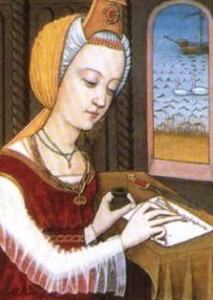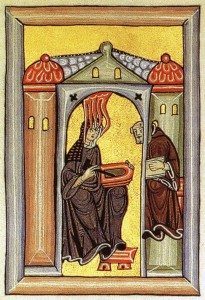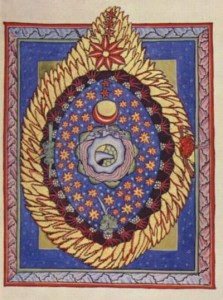Most people think of medieval women healers—if they think of them at all—as herb-women, maybe midwives, basically uneducated even by the standards of their time. But as I reported earlier, there’s evidence that a few women in the Middle Ages managed to get the same kind of training as their male counterparts. Some were even well enough respected that they were consulted, either in person or through their writings, by other physicians.
 The best-known medieval medical text supposedly by a woman is the thirteenth-century manual of obstetrics and gynecology (and cosmetics!) known by the name of its author, Trotula. How much education Trotula had is unknown, although she presents herself as a physician, implying university training.
The best-known medieval medical text supposedly by a woman is the thirteenth-century manual of obstetrics and gynecology (and cosmetics!) known by the name of its author, Trotula. How much education Trotula had is unknown, although she presents herself as a physician, implying university training.
Trotula says she wrote her book “to assist women . . . so that one woman may aid another in her illness and not divulge her secrets to . . . uncourteous men” who do not take women’s illnesses seriously.
Whether she ever existed is a matter of debate. Some scholars say that the text was too good to have been written by a mere woman, yet one critic maintains that it was so bad that its male author put a woman’s name on it to avoid being identified with it! Trotula’s name is found on the register of citizens of Salerno (home of a medieval medical school that had women on its faculty), and her manual was much read, copied, translated, and adapted, so at least for several centuries she was accepted as a real person.
The remarkable Hildegard of Bingen (1098-1179) didn’t have the benefit of formal medical training. In fact, for most of her life it never occurred to anyone that she would treat patients or even speak with anyone outside a very restricted circle. At the age of eight, Hildegard had entered a strict cloister and was expected to leave her convent alive.
Illness played an important role in Hildegard’s life. She had had visions since she was a child, but did not tell anyone about them until much later. The neurologist Oliver Sacks thinks that these visions were the result of the aura often experienced by people who suffer from migraine.
 Hildegard tended to fall ill when she didn’t get her own way. When the Abbott refused to allow her to establish her own convent, she fell ill with an apparently life-threatening sickness. When permission was granted, she recovered instantly. As prioress, Hildegard was responsible for health-care duties at her abbey.
Hildegard tended to fall ill when she didn’t get her own way. When the Abbott refused to allow her to establish her own convent, she fell ill with an apparently life-threatening sickness. When permission was granted, she recovered instantly. As prioress, Hildegard was responsible for health-care duties at her abbey.
Her first two books concern medical therapies, and this subject is treated in later works as well. Hildegard was quite interested in reproduction and in female sexuality. She stood accepted theories on their head, claiming that women were more passionate than men, and also that long-standing taboos against menstrual blood really should be applied to semen instead. Traditional medical theory said that men were hot-natured and women cold-natured; Hildegard insisted on the opposite, saying that the warmth of the womb is what ultimately gives life to the fetus.
She assigned the date of the onset of the menses at 15, and its cessation at 50 (roughly the same time-span as in the modern West).
Hildegard is also responsible for the first known description of female orgasm in Western literature. Characteristically, she assigns to women an active role in sexual activity:

The—er, cosmos, according to Hildegard
“When a woman is making love with a man, a sense of heat in her brain, which brings with it sensual delight, communicates the taste of that delight during the act and summons forth the emission of the man’s seed. And when the seed has fallen into its place, that vehement heat descending from her brain draws the seed to itself and holds it, and soon the woman’s sexual organs contract, and all the parts that are ready to open up during the time of menstruation now close, in the same way as a strong man can hold something enclosed in his fist.”
Elsewhere, Hildegard describes women more passively, saying that a woman during intercourse is similar to “the threshing floor pounded by many strokes [or] . . . land under the plough.”
Where would a woman cloistered for all of her early life (and much of her middle age) acquire such knowledge? Eventually eighteen women joined Hildegard in her enclosure, and it is possible that their conversations enlightened Hildegard about life outside the convent walls. Also, the abbey at Disibodenberg could have supplied texts for her to read during and after her enclosure.
Hildegard had more to struggle against even than the average woman of her time, and her vast store of knowledge and the intricately-composed texts and illustrations that she left behind were the result of an individual whose achievements and courage have rarely been matched.
Tracy Barrett is the author of numerous books for young readers, most recently Dark of the Moon (Harcourt) and The Sherlock Files series (Henry Holt). She lives in Nashville, TN, where until recently she taught Italian, Humanities, and Women’s Studies at Vanderbilt University.
